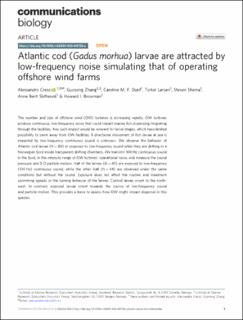| dc.contributor.author | Cresci, Alessandro | |
| dc.contributor.author | Zhang, Guosong | |
| dc.contributor.author | Durif, Caroline | |
| dc.contributor.author | Larsen, Torkel | |
| dc.contributor.author | Shema, Steven | |
| dc.contributor.author | Skiftesvik, Anne Berit | |
| dc.contributor.author | Browman, Howard | |
| dc.date.accessioned | 2023-10-19T07:18:15Z | |
| dc.date.available | 2023-10-19T07:18:15Z | |
| dc.date.created | 2023-05-02T17:19:53Z | |
| dc.date.issued | 2023 | |
| dc.identifier.citation | Communications Biology. 2023, 6 (1), 353-?. | |
| dc.identifier.issn | 2399-3642 | |
| dc.identifier.uri | https://hdl.handle.net/11250/3097421 | |
| dc.description.abstract | The number and size of offshore wind (OW) turbines is increasing rapidly. OW turbines produce continuous, low-frequency noise that could impact marine fish dispersing/migrating through the facilities. Any such impact would be relevant for larval stages, which have limited possibility to swim away from OW facilities. If directional movement of fish larvae at sea is impacted by low-frequency continuous sound is unknown. We observe the behavior of Atlantic cod larvae (N = 89) in response to low-frequency sound while they are drifting in a Norwegian fjord inside transparent drifting chambers. We transmit 100 Hz continuous sound in the fjord, in the intensity range of OW turbines’ operational noise, and measure the sound pressure and 3-D particle motion. Half of the larvae (N = 45) are exposed to low-frequency (100 Hz) continuous sound, while the other half (N = 44) are observed under the same conditions but without the sound. Exposure does not affect the routine and maximum swimming speeds or the turning behavior of the larvae. Control larvae orient to the northwest. In contrast, exposed larvae orient towards the source of low-frequency sound and particle motion. This provides a basis to assess how OW might impact dispersal in this species. | |
| dc.language.iso | eng | |
| dc.title | Atlantic cod (Gadus morhua) larvae are attracted by low-frequency noise simulating that of operating offshore wind farms | |
| dc.title.alternative | Atlantic cod (Gadus morhua) larvae are attracted by low-frequency noise simulating that of operating offshore wind farms | |
| dc.type | Peer reviewed | |
| dc.type | Journal article | |
| dc.description.version | publishedVersion | |
| dc.source.pagenumber | 353-? | |
| dc.source.volume | 6 | |
| dc.source.journal | Communications Biology | |
| dc.source.issue | 1 | |
| dc.identifier.doi | 10.1038/s42003-023-04728-y | |
| dc.identifier.cristin | 2144808 | |
| dc.relation.project | Havforskningsinstituttet: 15655 | |
| cristin.ispublished | true | |
| cristin.fulltext | original | |
| cristin.qualitycode | 1 | |
